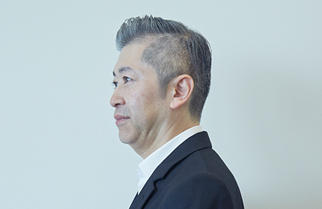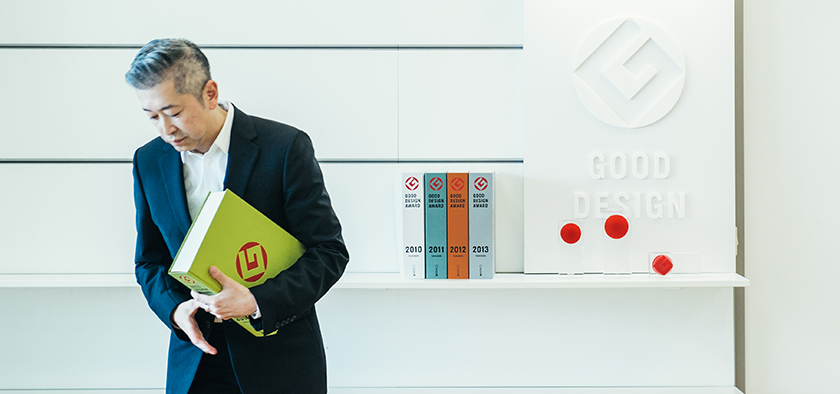
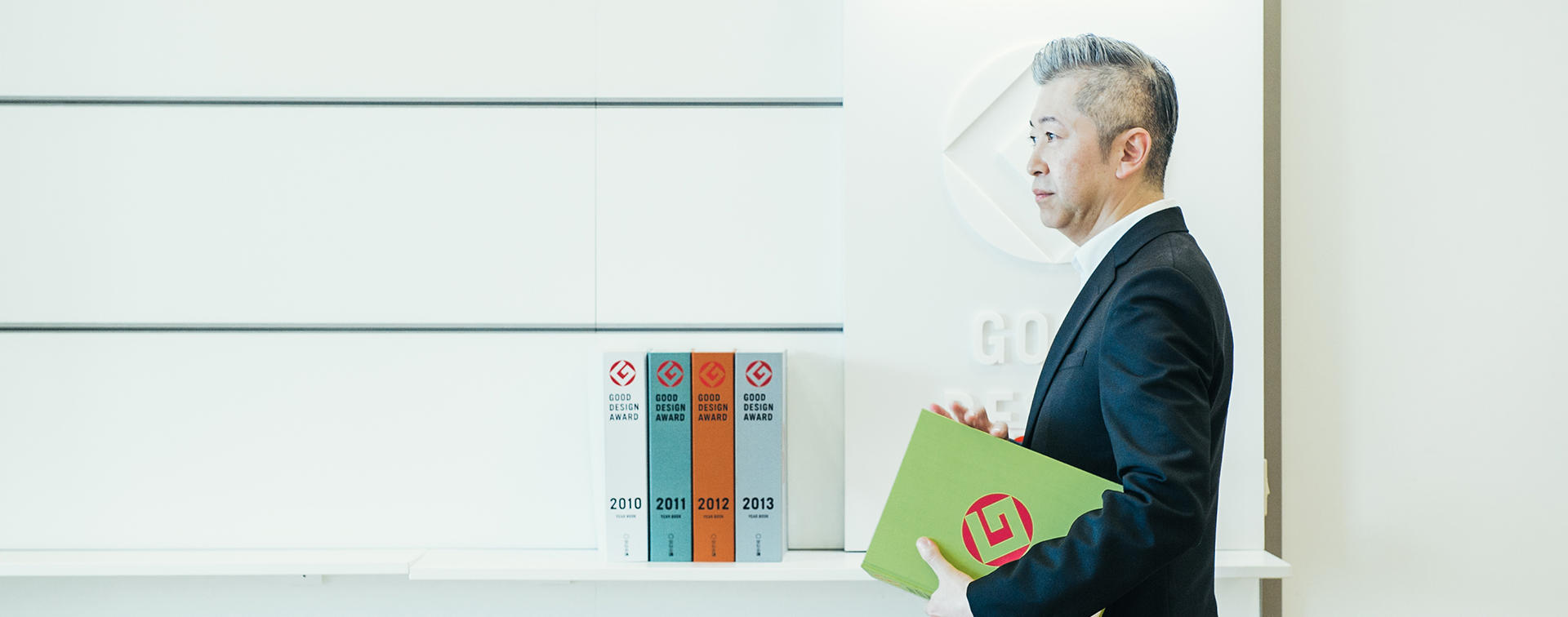
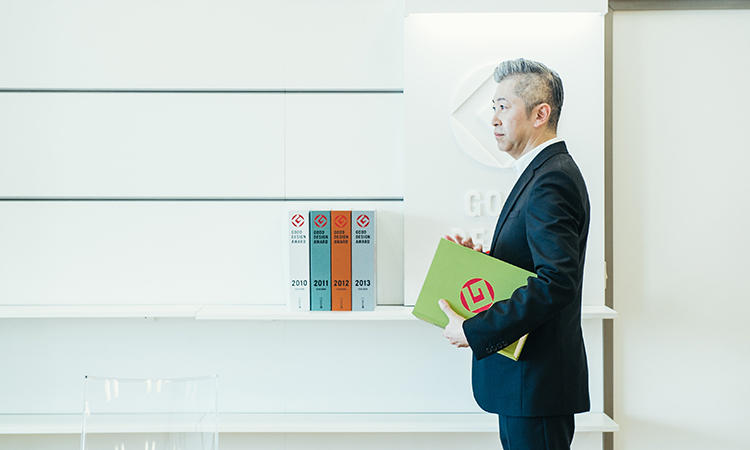
Turning Roppongi into an area for good designs
A special design zone, shared offices and meaningless spaces
Art director Kazufumi Nagai, head of Hakuhodo Design, has undertaken numerous advertising and branding projects including those for Suntory's "Iemon" green tea, Toyota's Lexus car and Palace Hotel Tokyo. This year, Nagai became chairman of the Good Design Award judging committee. We asked him about the Good Design Award and the role of designs in the future, and of course, about his ideas for turning Roppongi into an area for good designs.
Why I decided to chair the Good Design Award judging committee
I honestly did not imagine in the least that I would be nominated chairman of the Good Design Award Judging Committee. That's because the Good Design Award is generally seen to be an award for product design. Naoto Fukasawa-san, the previous chairman, and all the chairs so far have mostly been product designers. The designs I do are in the areas of communication and branding, and so I was a little uncertain at first about accepting the nomination.
The Good Design Award was set up by the ministry of trade and industry after World War II at a time when Japanese products were of unsophisticated design and when lots of copies were being made of overseas products. By establishing the award, the ministry hoped to rectify the situation. During Japan's era of high economic growth, the award encouraged designers to come up with new designs for new technology. It helped improve the quality of people's lives, and drive the Japanese manufacturing industry into a powerful industry. That was an era when the beauty of physical form gave birth to new values.
The design of products is still important of course, but I think the role of design today is to bring about innovation by providing solutions to problems that can't be solved in conventional ways or by helping to expand certain ideas. I accepted the nomination for chairman of the judging committee when I realized that by assuming the position, I would have the opportunity to slightly widen the range of genres in the Good Design Award.
The new Topical Issue that cuts across categories
At this year's Good Design Award, we launched a new category called "Topical Issue". Topical issue refers to an area where designs are expected to be particularly important in the future. The categories in the award have so far been vertically divided, but by introducing this category, we hope to also look at things horizontally - in other words, to take a wider perspective.
For example, SNS (social networking service) and cafés used to be in different categories. But since they are both about communities, we thought we could place them in the same category. So we set up 12 themes such as "community/locality", "infrastructure/mobility", and "global environment/energy" and a special team of "Topical Issue Directors" will be looking at the entries in all the categories based on these themes.
Until now, the Good Design Award has mainly been about exhibiting the award-winning works and informing people about the various values and background stories, but we wanted to take this a step further. With the Topical Issue system, we will be discussing the possibilities of designs for the future. The team of Topical Issue Directors will observe the entries and hold discussions, and the content of their talks will be given as reference in the screening of the Special Awards, and presented as "proposals" at the Good Design Exhibition. The Topical Issue is a new standard, and a new way of sending out information.
The unchanging goal of designs
The ultimate goal of designs is for everyone to lead happy lives. That goal has not changed since the Arts and Crafts movement, but there are now more areas where designs are seen to matter.
At the Good Design Award in 2012, Naoto Fukasawa-san, then chairman of the judging committee, incorporated the concepts of "interactivity" and "system" in the evaluation process. Instead of "system", one could also use the word "platform." In 2012, the QR code won the Good Design Award. In the past, if something like the QR code had been awarded for good design, I think people would have found it difficult to understand. The award was also given several years ago to a painless injection needle for diabetes patients. It was awarded not so much for its appearance, but for its functional, social design.
The meaning of good designs will change over the years, and so will their functions. When we look at the history of the Good Design Award, I think we can say that the award itself helped establish the concept of innovative designs. The Topical Issue we started this year is a move taken in line with the times.

Public perception and what is really going on in the design industry
Japan is now experiencing a big change in its social and industrial structure as it shifts from a high growth economy to a mature economy. From now on, designs will be crucial in realizing the kind of lifestyles and society we want to have. Meanwhile, the change in the industrial structure is leading to the creation of new genres such as the IoT (Internet of Things) and robotics. At the same time, designs, as in the past, will continue to be important for products that incorporate new technology. So there are two kinds of designs - designs for society and designs for industry.
JAGDA (Japan Graphic Designers Association) recently compiled the JAGDA Report (published by Seibundo Shinkosha). People generally seem to think that the glamorous part of the graphic design industry is the creation of posters, and that the people who make posters are the graphic designers, but the industry has changed considerably. The typical graphic designer in most people's minds is Yusaku Kamekura-san, but there are other designers like myself doing work that is quite different. There is a gap between the perception held by the general public and what is actually going on in the graphic design industry, and this JAGDA Report was compiled in the hope of bridging that gap.

JAGDA (Japan Graphic Designers Association Inc. ) Report
A report that looks into the projects and thought processes of contemporary graphic designers such as Kenya Hara, Kashiwa Sato, and Taku Sato. The magazine is published for JAGDA members but is also available in bookstores. (price:1,000 yen tax excluded)
The meaning of "good designs" will change over time
The book is divided into three sections: upstream designs, social designs and expanding designs. Let me explain each briefly. Upstream designs is about designs at the upstream part of the production process - about designers being involved with concepts and manufacturing instead of just deciding on the shape of products. Social designs refer to the designs in areas such as education, neighborhoods and communities - areas where designs have traditionally not been taken utilized. Expanding designs are about how graphic designers are expanding their work in different areas such as websites, fashion and architectural space.
People might have set perceptions about designs, but areas where designs are needed are growing, and the designers themselves are breaking new ground. This is a trend that will continue into the future. What people mean by "good designs" is changing too. Instead of using the phrase to describe things that have a fairly pleasant shape, they might now say things like: "This community in Roppongi is well designed."
The need to fill in the spaces in Roppongi
I think that in order to turn Roppongi into an area for good designs, the spaces between the facilities need to be filled. I've always felt that the vacant spaces are a problem.
Roppongi Hills, Tokyo Midtown, the National Art Center, Tokyo, and the design-related facilities such as AXIS and Aoyama Book Center are all a little far from each other, and perhaps that is partly why people only go to just one facility and not to the others. I myself find that when I go to AXIS or Tokyo Midtown, I usually don't visit the other places. Roppongi has so much potential as an area to send out information on design, and it's a big problem that the various facilities are not linked together. If these spaces were filled, I believe Roppongi would become even more attractive.
There must be all kinds of ways to fill in the spaces and turn Roppongi into an area that brims with good designs. One way would be to set up nice shops and restaurants. But I suppose the vital thing is for Roppongi to have the power to attract designers, creative people and creative industries.
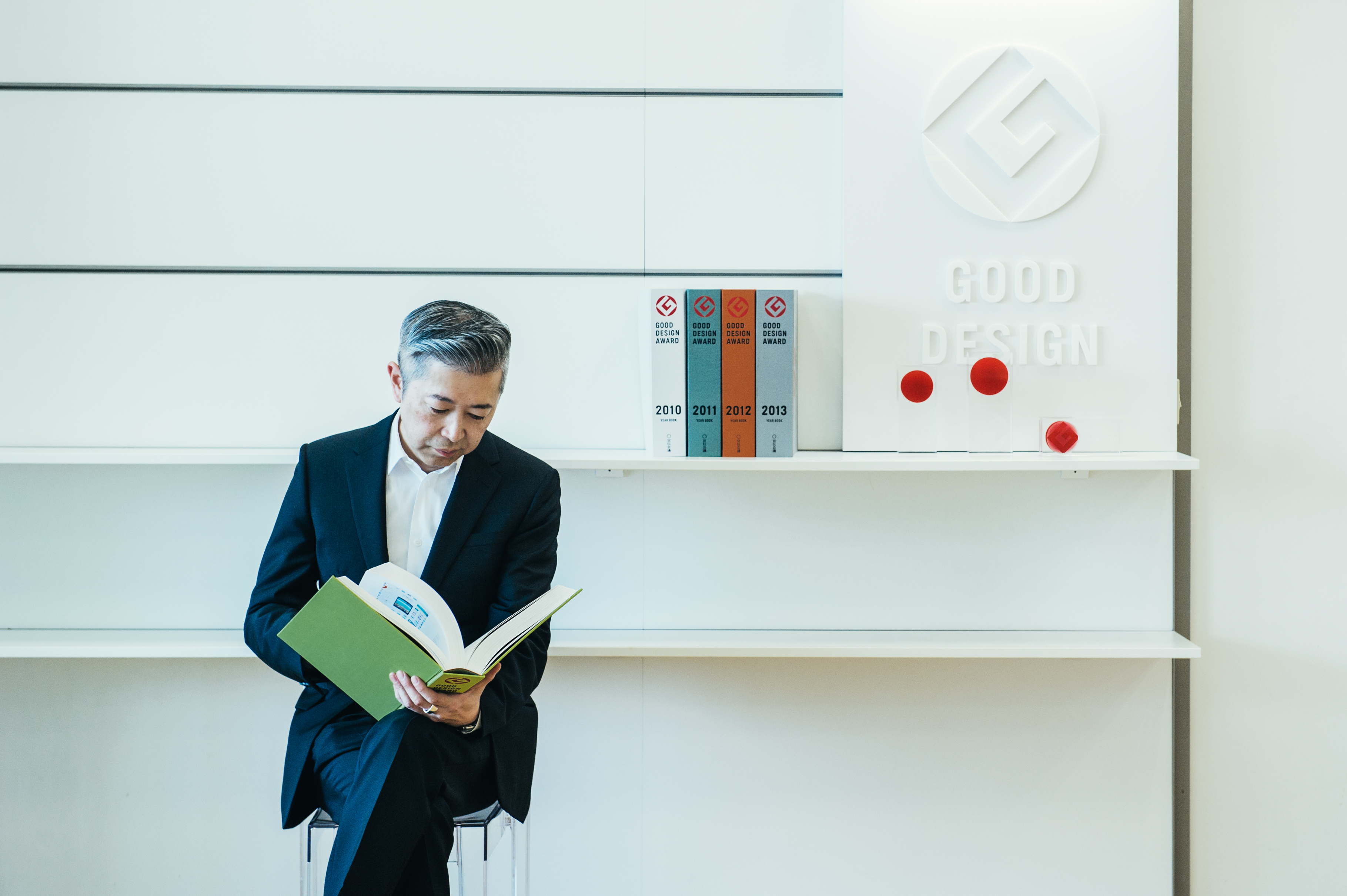
An area for creators to live, work and have fun
At the moment, many designers still choose to have their offices in Aoyama or Jingu-mae instead of Roppongi. These places have a good image, but more importantly, they have environments and infrastructure that are convenient for working. And they have pleasant cafés, and are populated by creators doing the same kind of work who inspire each other.
Tokyo has recently started promoting the "Special Zone for Asian Headquarters" with the aim to invite overseas companies. Perhaps administrative steps should be taken to set up a similar zone for designers - a special design zone. I think this would help send out a clear message to the public that there is a will to make Roppongi a more creative place. Perhaps it would be a good idea to build shared offices that are limited to designers. An area where creators can live, work and have fun, will surely have the effect of luring creative people and industries.
For this interview right now, we are sitting here at the Design Hub on the fifth floor of Midtown Tower. Design organizations like the Japan Institute of Design Promotion (JDP) and JAGDA are gathered here. The Design Hub is a good example of how coming together naturally draws more people and more information.

Tokyo Midtown Design Hub
A design facility that opened in April 2007, consisting of Japan Graphic Designeres Association Inc. (JAGDA), the Japan Institute of Design Promotion (JDP), theMusashino Art University Design Lounge (D-LOUNGE) and the International Design Liaison Center. The design-related organizations, each variously involved in promotion, professional skills, education and research, cooperate in holding exhibitions, seminars and publishing.
A public square-like space like THINK ZONE
I was born in Tokyo's Akasaka district, so Roppongi is a place that I feel close to. Many people probably think of Roppongi as being a night town or an entertainment area, but partly because I don't drink, Roppongi for me, is a cultural area. During high school and college, I often went to Aoyama Book Center and the Living Motif store. The building isn't there anymore, but I also used to browse CDs at the WAVE store and then go down to the basement to the Cine Vivant movie theater to watch a movie. In those days, there was no other place that was so polished and sophisticated.
Another impressive place was the ROPPONGI THINK ZONE, which existed a little before Roppongi Hills was built. I used to go there after work to drink tea or look at the books for sale. While it was a place that had no particular artwork, it was a really stimulating space that gave people a taste of the future of Roppongi. WAVE and THINKZONE disappeared after Roppongi Hills and Tokyo Midtown were completed, but I feel that they were the prototypes for the area of design and art which Roppongi has become today.
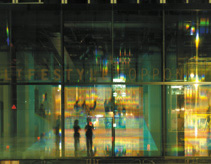
ROPPONGI THINK ZONE
An art space, now closed, that opened on Roppongi Dori street in 2001 as a project to precede the building of Roppongi Hills. Its interior was designed by Tokujin Yoshioka, and the art direction was by Bruce Mau. Many innovative visual and sound events were held.
In that regard, I think that what we need are meaningless spaces rather than spaces with a significant purpose. An in-between kind of place like a public square would be ideal for Roppongi. Designers could make presentations there or hold workshops and events. Interesting things would naturally happen then.
What Roppongi could become a hundred years from now
For the last few minutes, I've been wondering which town in Tokyo I like, and Ochanomizu just came to mind. It has universities, secondhand bookshops and many old cafés as well as restaurants which serve reasonably priced "teishoku" (meal sets). Ochanomizu is a town which has accumulated history. The same kind of atmosphere can be found in Kunitachi which is a place I lived in for two years. It also has universities, and secondhand bookshops and too many good cafés. (laughs) All the streets in both Ochanomizu and Kunitachi have a distinct atmosphere.
That kind of atmosphere sadly can't be found in Roppongi; this area is still an isolated dot. It is history that creates that distinct atmosphere, and it's not something that can be achieved overnight. But if steady efforts are made to fill in the spaces between the dots, maybe in around a hundred years, Roppongi will become a world-class area for good designs.
Editor's thoughts
Nagai-san told us that different "schools" exist in designers' job titles. While there are designers such as Hara Kenya-san and Taku Sato-san who choose "graphic designer" as their title, Nagai said that he describes himself as an art director since he originally worked in the advertising industry. It might be interesting to look at the profiles of various creators and take note of their titles.(edit_kentaro inoue)




